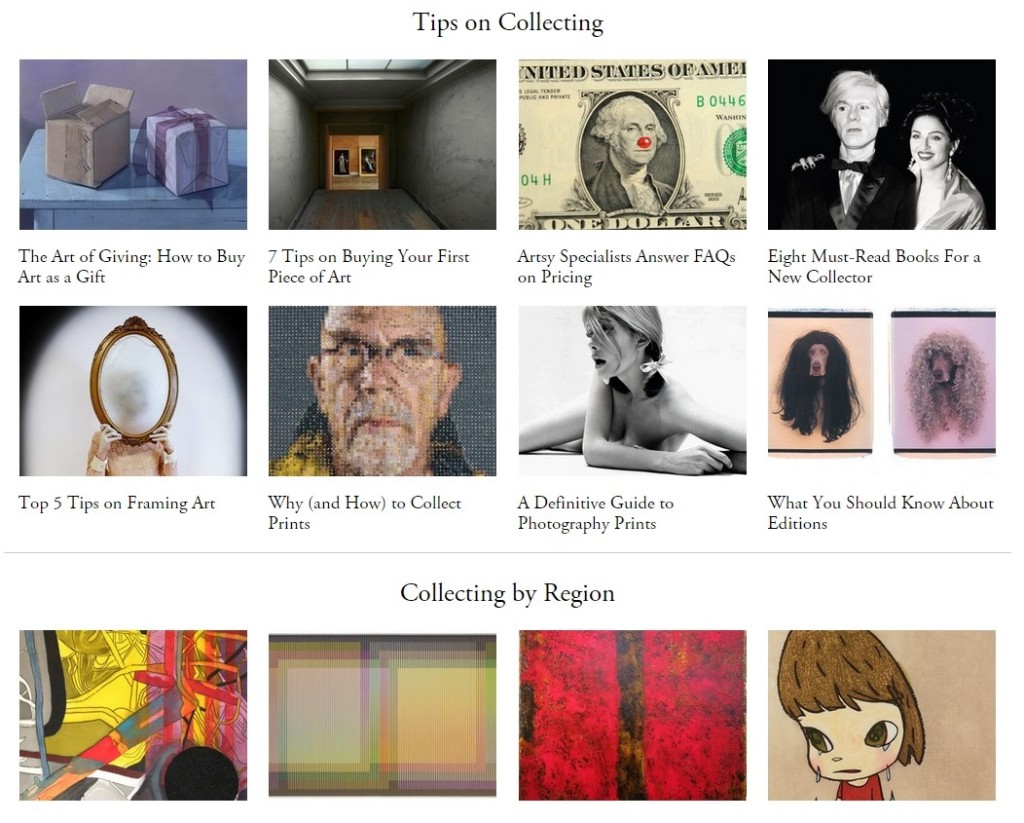Do you love art? I certainly do. Especially works like Jeff Koons’ Michael Jackson and Bubbles (courtesy of Artsy).
While I’m not an art collector myself, I enjoy visiting art galleries and museums. I relish uncovering the rich and multi-layered narratives behind each and every artwork, immersing myself in aesthetic experiences which transport me from the ordinary to the sublime.
I guess this was why I spent 10 years of my life working in a museum oriented organization.
Beyond occasional escapes into the world of art, I’m also a technology freak. More precisely, a digital and content marketing geek. I’ve always been intrigued by how the world of art and digital can coalesce, riding on each other’s strengths.
I suppose this is why I’m so impressed with Artsy.
Over 230,000 Images of Art, Architecture and Design
Founded by 27 year old Princeton Computer Science graduate Carter Cleveland (you can read a little about him here), Artsy is an art portal that seeks to bring the world’s leading galleries, museum collections, foundations, artist estates, art fairs, and benefit auctions, all in one place. With a huge and growing database of over 230,000 images of art, architecture and design, Artsy has the largest online databse of contemporary art. Over 25,000 artists are featured on the website.
Investors to Artsy include heavyweights like Twitter’s Jack Dorsey, Google’s Eric Schmidt and mega-art dealer Larry Gagosian. Together, they have pumped $14.5 million into the company. In fact, Cleveland hopes to become the “Amazon for the art world.” Sounds like the young man’s got a plan!
So what makes Artsy stand out from other art websites, online galleries, and portals?
1) Clean and Contemporary Website Design

One of the cardinal rules in the world of art marketing is this: aesthetics matter. A whole lot. The greatest works of art can look like a dog’s breakfast on a poorly designed website.
Artsy is both beautifully designed and functional. There is sufficient white space surrounding each gallery and artwork to allow the eye to rest and focus. Visual clutter and distractions are kept minimal. Images are tastefully laid out. Most importantly, the website draws you in with the inviting ambience of a museum gallery.
2) Sheer Breadth and Depth of Art Content
I am amazed at the sheer amount of content on Artsy. Beyond the sheer number of artworks and artists featured online, Artsy’s editorial team also covers the latest art events in major art markets around the world. They include past and present museum exhibitions, gallery openings, art fairs, art biennales and various other happenings. This is content marketing at its best.
Other than the width and depth of its scope, Artsy also has this quirky science-meets-art initiative called the Art Genome Project. Quoting from the website:
“The Art Genome Project is the classification system and technological framework that powers Artsy. It maps the characteristics (we call them “genes”) that connect artists, artworks, architecture, and design objects across history. There are currently over 1,000 characteristics in The Art Genome Project, including art historical movements, subject matter, and formal qualities.”
3) Consumer-Friendly Art Educational Resources
Art appreciation and collection is often about education. The more you learn, the more intriguing the work of art becomes.
Once again, Artsy scores in this aspect of content marketing. The website offers more than 26,000 high-resolution images of art and architecture from it’s database to be freely downloaded for educational use. A “Download Image” button is conveniently placed beside these images for ease of access.
Beyond this, Artsy also takes pains to describe each of the different art movements on its website. It provides educational content and context through art historical posts that cover the lives, movement, works, and stories that make up the history of art. Over 5,000 artist biographies are also available for perusal. An example is this page on renowned American pop artist Roy Lichtenstein.
4) User-Friendly Web Navigation and Search
As you can see from the image above, Artsy allows users to browse and search through multiple categories. These range from art movements, A-Z classifications, to galleries/museums, prices, medium, and sizes. Beyond these, I love how it uses suggested categories and links to encourage serendipitous social discovery (“Amazon-ly” familiar?) while helping users to navigate its encyclopedic resources.
5) Curate, Collect and Share Art Easily
Through various tools such as a “Follow” button, Social Sharing buttons (Facebook, Twitter, Email, etc), and an online app to build your own collections and curate artworks, users are empowered to interact and socialize with Artsy’s virtual collection of artworks. Building social interactivity is important as it encourages web surfers not only to customise their own artwork “collections” but to share it with their friends online.
Features that encourage users to build their own “curated content” online is a vital step in content marketing. These functionalities also help to create further Word Of Mouth and buzz amongst like-minded art lovers who are socially connected.
6) Minimal Art Speak or Jargon
As a former Communications Director in an art organisation, one of my pet peeves was having to translate alien “art speak” and curatorial jargon into something that ordinary humans would understand. In this regard, Artsy scores yet again. I like how it avoids obtuse artistic expressions or convoluted terms in the way it describes the backgrounds and movements of art.
Making the art world accessible to the “unwashed” masses is a great marketing strategy. Artsy certainly knows this.
7) Artful Selling (Sans Crass Commercialism)
Last, but certainly not least, Artsy doesn’t try to push art like a commodity (thank goodness!). It knows that the world of art purchase, collection and dealing is not about hard hustling with “buy 2 get 1 free” deals or “50% off” fire sales. No living (and dead) artist would appreciate seeing his or her works of art becoming a commodity.
While there are features which allow you to participate in online art auctions or to purchase desired artworks, the selling process is done unobtrusively and elegantly. This befits the status of the artworks while enhancing the experience of online art purchases. It is also a cardinal rule in content marketing: avoid hardselling and only do so after you’ve earned the trust of your followers.
Go check out Artsy today and let me know what you think. And no, this isn’t a sponsored post. 🙂
<All images above courtesy of Artsy>




Find Your favorite original oil paintings from oilpaintings-forsale.com, We can Free Shipping worldwide!